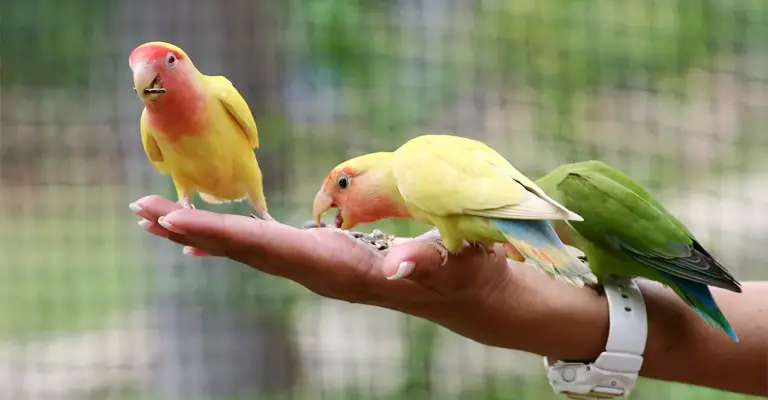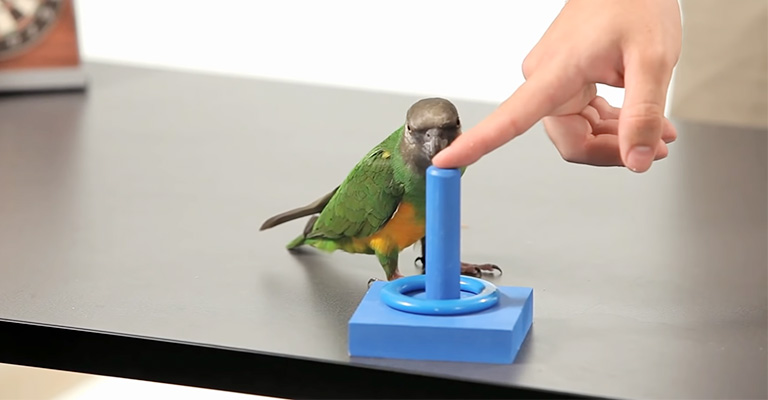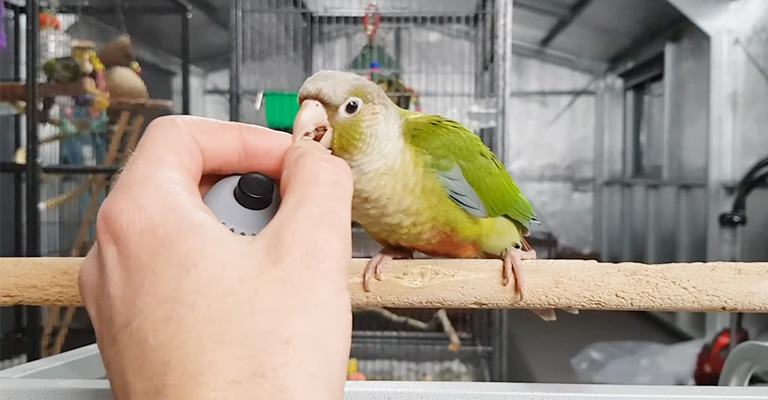Conures are beautiful and intelligent birds that make wonderful companions. These lively and social creatures have a natural curiosity and a knack for learning new tricks. However, training a Conure requires patience, consistency, and a solid understanding of their behavior.
So, how to train a Conure? You can try the target training or clicker training method to train your Conure. Step-up and recall training are also highly effective. The key is to build trust, have patience, and create a positive environment for the bird.
Let’s explore the factors to consider while training your conure and the step-by-step methods to train them.
![How to Train A Conure? [Tackling Common Training Challenges]](https://theworldsrarestbirds.com/wp-content/uploads/2023/06/How-to-Train-A-Conure.jpg)
How to Train A Conure?
Teaching your conure is a time-consuming and difficult task. To do it properly, you should consider the following factors-
Establish Trust
Building a strong bond based on trust is crucial before embarking on any training regimen. Spend time with your Conure, offering treats and positive reinforcement. Allow them to become familiar with your presence and gradually work on gaining their trust.
Positive Reinforcement
Conures respond well to positive reinforcement, such as treats, praise, and affection. Use these rewards to motivate and reinforce desired behaviors during training sessions.
Consistency

When training any pet, consistency is the key and Conures are no exception. Set a regular training schedule and stick to it. This will help your Conure understand what is expected of them and establish a routine.
Understand Body Language
Conures communicate through their body language. It is important to observe their cues and understand their emotions. This will help you gauge their comfort levels and tailor your training sessions accordingly.
Patience
Training a Conure takes time and patience. Each bird is unique and learns at their own pace. Be patient, and avoid rushing or pushing your Conure too hard. Remember, training should be a positive and enjoyable experience for both of you.
Step-by-Step Guidelines to Train a Conure

Target training is an effective way to train a conure and can be a fun and interactive activity for both you and your bird. Here’s a step-by-step guide on how to target train your conure:
Step 1 – Gather the Necessary Materials
You’ll need a target stick or a small, lightweight object like a wooden dowel with a colorful ball or pom-pom attached to the end. Ensure it’s safe for your conure to touch.
Step 2 – Familiarize Your Conure with the Target Stick
Introduce the target stick to your conure by placing it near the bird’s perch or within its reach. Allow your conure to investigate and get comfortable with the object. You can also hold it and move it around gently to catch your conure’s attention.
Step 3 – Establish a Positive Association
Use treats that your conure loves, such as small pieces of its favorite fruit or a nut. Show the treat to your conure and let it see you place the treat on the end of the target stick. This will create a positive association between the target stick and the reward.
Step 4 – Present the Target Stick
Hold the target stick so that the treatment is just out of your conure’s reach but still visible. Make sure your conure is paying attention to the target stick.
Step 5 – Encourage the Conure to Touch the Target Stick
Say a command like “touch” or “target” and gently move the target stick closer to your conure. The goal is to encourage your conure to reach out and touch the target stick with its beak.
Step 6 – Reward the Conure
The moment your conure touches the target stick, offer immediate praise and give it a treat. Reinforce positive behavior by praising and rewarding your conure each time it successfully touches the target stick.
Step 7 – Repeat and Increase Difficulty
Be sure to repeat the process and gradually increase the distance between the target stick and your conure. With each successful touch, reward your conure and provide verbal praise.
You can also begin incorporating slight movements or changes in the target stick’s position to challenge your conure.
Step 8 – Expand the Training
Once your conure is comfortable with target training, you can use the target stick to teach other tricks or behaviors. For example, you can guide your conure to turn around or move in a specific direction by moving the target stick accordingly.
Effective Tips to Train a Conure

Training a conure using clicker training can be an effective and enjoyable way to teach them new behaviors. Clicker training utilizes a clicker, which makes a distinct sound, to mark the desired behavior, followed by a reward.
Here are some tips on how to train your conure using clicker training:
Familiarize Your Conure with the Clicker
Before starting the training, introduce the clicker to your conure to associate the sound with rewards. Click the clicker and immediately offer a treat. Repeat this several times, ensuring your conure is comfortable with the sound and understands that it predicts a treat.
Choose a Behavior
Decide on a behavior you want to train your conure. Start with simple behaviors like targeting (touching a specific object with its beak) or stepping onto your finger.
Break Down the Behavior
Divide the desired behavior into smaller, achievable steps. For example, if you want to train your conure to step onto your finger, the steps could be: (a) Approaching your finger, (b) Touching your finger with its beak, (c) Placing one foot on your finger, and (d) Stepping fully onto your finger.
Start the Training Session
Begin the training session by ensuring your conure is alert and focused. Hold the clicker in one hand and the treat in the other.
Click and Treat
Present a cue or create a situation where your conure is likely to perform the first step of the behavior. As soon as your conure performs the desired action, click the clicker and immediately offer a treat.
Generalize the Behavior
Practice the behavior in various settings and with different distractions. This helps your conure understand that the behavior is expected in different situations.
Create a Positive Environment
Ensure that your conure is in a comfortable and secure environment, free from distractions. A calm and quiet space will help your conure focus on the training.
Start with Basic Sounds
Begin by exposing your conure to different sounds and vocalizations. Repeat simple and clear words or phrases, such as their name, in a gentle and encouraging tone. Consistency is key, so repeat these words or phrases regularly.
Use Positive Reinforcement
Reward your conure with treats, praise, or gentle petting when they mimic or attempt to vocalize the sounds or words you’ve been practicing. This positive reinforcement will motivate them to continue vocalizing.
Be Patient
Training takes time and each conure progresses at its own pace. Be patient and understanding throughout the process. Avoid getting frustrated or raising your voice, as this can discourage your conure.
Imitate Your Conure
Conures are social birds and are more likely to imitate sounds that they perceive as coming from their flock or companions. Mimic their vocalizations and encourage them to mimic you in return. This can create a back-and-forth interaction that helps develop their vocal skills.
Use Audio Aids
You can find audio recordings or videos of conure vocalizations online. Play these sounds for your conure to listen to and imitate. Hearing other conures vocalize can provide inspiration and help them learn new sounds.
Practice Regularly
Consistency is crucial for training. Set aside regular training sessions, preferably at the same time each day. Short, frequent sessions are more effective than longer, infrequent ones.
FAQs
The time it takes to train a Conure varies depending on the bird’s personality and the complexity of the desired behaviors. It can take weeks or even months to achieve mastery of certain commands or tricks. Patience and consistency are essential.
Yes, older Conures can be trained, although they may take longer to learn new behaviors compared to younger birds. The training process may require additional patience and persistence, but it is still possible to teach an older Conure some new tricks.
If your Conure shows signs of resistance or aggression, it is important to evaluate their comfort levels and seek guidance from an avian behaviorist or an experienced bird trainer. They can provide insights and strategies to address specific behavioral issues.
Conures have short attention spans, so it is generally more effective to train them in short, frequent sessions of about 10-15 minutes. This keeps the training sessions engaging and prevents them from becoming bored or frustrated.
It is not recommended to use punishment or aversive techniques when training Conures. Positive reinforcement is a more effective and humane method that helps build trust and strengthens the bond between you and your feathered friend.
Final Thoughts
So, now you know how to train a Conure. Training a Conure is an enriching experience that strengthens the bond between you and your feathered companion.
By considering the factors mentioned above, employing positive reinforcement techniques, and maintaining consistency, you can effectively train your Conure.
Remember to be patient, observe their body language, and tailor your training sessions to their individual needs. With time and dedication, you and your Conure will enjoy a rewarding and fulfilling training journey together.